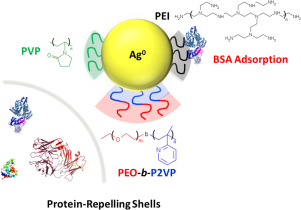Biomaterials Advances ( IF 5.5 ) Pub Date : 2020-03-13 , DOI: 10.1016/j.msec.2020.110850 Carin C.S. Batista , Lindomar J.C. Albuquerque , Alessandro Jäger , Petr Stepánek , Fernando C. Giacomelli

|
The use of noble metal nanoparticles in biomedical and biotechnological applications is nowadays well established. Particularly, silver nanoparticles (AgNPs) were proven to be effective for instance as a biocide agent. They also find applications in tumor therapies and sensing applications being encouraging tools for in-vivo imaging. In this framework, whenever they are in contact with living systems, they are rapidly coated by a protein corona thereby influencing a variety of biological events including cellular uptake, blood circulation lifetime, cytotoxicity and, ultimately, the therapeutic effect. Taking these considerations into account, we have explored the behavior of polymer-coated AgNPs in model protein environments focusing on the self-development of protein coronas. The polymers polyethyleneimine (PEI), polyvinylpyrrolidone (PVP) and poly(2-vinyl pyridine)-b-poly(ethylene oxide) (PEO-b-P2VP) were used as stabilizing agents. The chemical nature of the polymer capping remarkably influences the behavior of the hybrid nanomaterials in protein environments. The PEO-b-P2VP and PVP-stabilized AgNPs are essentially inert to the model proteins adsorption. On the other hand, the PEI-stabilized AgNPs interact strongly with bovine serum albumin (BSA). Nevertheless, the same silver colloids were evidenced to be stable in IgG and lysozyme environments. The BSA adsorption into the PEI-stabilized AgNPs is most probably driven by hydrogen bonding and van der Waals interactions as suggested by isothermal titration calorimetry data. The development of protein coronas around the AgNPs may have relevant implications in a variety of biological events. Therefore, further investigations are currently underway to evaluate the influence of its presence on the cytotoxicity, hemolytic effects and biocide properties of the produced hybrid nanomaterials.
中文翻译:

探索蛋白质在聚合物稳定的银纳米胶体上的吸附,以更好地了解生物分子电晕的演变和后果
如今,在生物医学和生物技术应用中使用贵金属纳米颗粒已广为人知。特别地,银纳米颗粒(AgNP)被证明是有效的,例如作为杀生物剂。他们还发现在肿瘤治疗中的应用以及传感应用是体内研究的令人鼓舞的工具成像。在这种框架下,每当它们与生命系统接触时,它们都会迅速被蛋白质电晕所覆盖,从而影响各种生物学事件,包括细胞摄取,血液循环寿命,细胞毒性以及最终的治疗效果。考虑到这些因素,我们探讨了模型蛋白环境中聚合物包被的AgNPs的行为,重点是蛋白电晕的自我发展。聚合物聚乙烯亚胺(PEI),聚乙烯吡咯烷酮(PVP)和聚(2-乙烯基吡啶)-b-聚环氧乙烷(PEO - b- P2VP)用作稳定剂。聚合物封端的化学性质显着影响杂化纳米材料在蛋白质环境中的行为。PEO- b-P2VP和PVP稳定的AgNP对模型蛋白的吸附基本上是惰性的。另一方面,PEI稳定的AgNP与牛血清白蛋白(BSA)强烈相互作用。然而,同样的银胶体被证明在IgG和溶菌酶环境中稳定。BSA吸附到PEI稳定的AgNPs中的吸附很可能是由氢键和范德华力相互作用驱动的,这由等温滴定量热数据表明。AgNPs周围蛋白质电晕的发展可能在各种生物学事件中具有相关的含义。因此,目前正在进行进一步的研究以评估其存在对所产生的杂化纳米材料的细胞毒性,溶血作用和杀生物特性的影响。











































 京公网安备 11010802027423号
京公网安备 11010802027423号